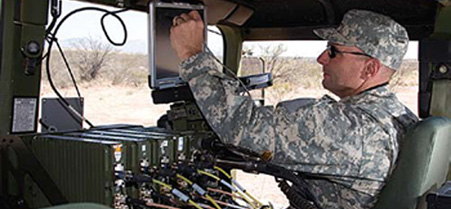Army seeks 5,000 JTRS vehicle radios
Single-channel system will run on software used in handheld and backpack radios.
 Defense Department
Defense Department
Results from two network integration evaluations at White Sands Missile Range, N.M., helped the Army fashion a new procurement notice for 5,000 vehicle radios that run software for handheld and backpack Joint Tactical Radio System devices.
Lt. Col. Troy Crosby, the Army's product manager for network systems, said soldiers identified the need for the new vehicle radios at the NIEs in November 2011. The devices will be acquired through what the service calls an agile process, which is designed to identify and then quickly acquire new network capabilities at a lower cost than traditional and often years long acquisition methods.
"The last NIE was an excellent chance to look at how single-channel, vehicle-mounted radio solutions align with the Army's network modernization plans," Crosby said. "Soldier feedback and test data indicate that these solutions will meet operational needs as a vital communications link to the tactical edge."
Col. Dan Hughes, director of the Army's director of systems integration, said the vehicle radio procurement "illustrates how the NIEs and the agile process allow the Army and industry to work together to quickly fulfill our network hardware and software capability gaps."
Beginning in 2013, the Army plans to field handheld Rifleman Radios that run the Soldier Radio Waveform -- software that defines bandwidth, modulation and frequency range to eight brigade combat teams.
Rifleman Radios are carried by platoon, squad and team-level soldiers. They connect soldiers to one another and back to their leaders at the company level so they can rapidly exchange information. The Rifleman Radio operates in the 225 MHz-450 MHz, 1250 MHz-1390MHz, and 1755 MHz-1850 MHz frequency bands.
The Army said the new vehicle radio announced Tuesday will connect the foxhole to brigade tactical operations centers and interoperate with radio systems that currently connect the brigade to the Warfighter Information Network-Tactical, a wide-area satellite and terrestrial battlefield communications system.
The government owns the Soldier Radio Waveform. In the sources-sought notice that was issued Tuesday, the Army asked interested vendors how they would incorporate that software into radio hardware that will be installed in a vehicle mount.
Dennis Moran, a retired Army major general who serves as vice president of government business Development for the RF Communications division of Harris Corp., said his firm plans to bid on the vehicle radio procurement. Harris will use the guts of its AN/PRC-152-A wideband handheld radio and expects pricing for the Army vehicle Soldier Radio Waveform devices to be less than $20,000.
The Army said it plans to award this August an indefinite delivery-indefinite quantity contract for the vehicle radios and expects the first delivery in October.
The JTRS Program Executive Office is expected to kick off procurement this month for 10,000 radios that run the Soldier Radio Waveform and a broadband radio waveform to replace the Ground Mobile Radio the Pentagon terminated last year.
Army Brig. Gen. Michael Williamson, program executive officer, predicted at an industry conference last month that costs for these two-channel radios will run from $60,000 to $80,000, a sharp drop from the $150,000 he estimated in October 2011.






